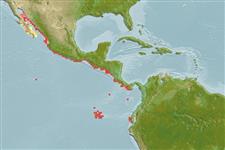Environment: milieu / climate zone / depth range / distribution range
Ecology
Marine; demersal; depth range 2 - 8 m (Ref. 96339). Tropical; 30°N - 3°S, 114°W - 81°W (Ref. 114953)
Eastern Central Pacific: Mazatlán, Mexico to Ecuador, including Galapagos Islands.
Length at first maturity / Size / Weight / Age
Maturity: Lm 48.5, range 44 - ? cm
Max length : 118 cm TL male/unsexed; (Ref. 111131)
Benthic in shallow waters over sandy bottoms (Ref. 9262). Ovoviviparous (Ref. 50449). Produces litters of 1-6 pups. Females mature at ca. 48 cm TL, males at ca. 51 cm TL; born at 19 cm TL (Ref. 114953).
Exhibit ovoviparity (aplacental viviparity), with embryos feeding initially on yolk, then receiving additional nourishment from the mother by indirect absorption of uterine fluid enriched with mucus, fat or protein through specialised structures (Ref. 50449).
McEachran, J.D., 1995. Rhinobatidae. Peces guitarra. p. 778-781. In W. Fischer, F. Krupp, W. Schneider, C. Sommer, K.E. Carpenter and V. Niem (eds.) Guia FAO para Identification de Especies para los Fines de la Pesca. Pacifico Centro-Oriental. 3 Vols. FAO, Rome. (Ref. 9262)
IUCN Red List Status (Ref. 130435: Version 2024-1)
Threat to humans
Harmless
Human uses
Fisheries: subsistence fisheries
Tools
Special reports
Download XML
Internet sources
Estimates based on models
Preferred temperature (Ref.
123201): 26.6 - 29.1, mean 28.3 °C (based on 115 cells).
Phylogenetic diversity index (Ref.
82804): PD
50 = 0.5039 [Uniqueness, from 0.5 = low to 2.0 = high].
Bayesian length-weight: a=0.00186 (0.00120 - 0.00289), b=3.12 (2.99 - 3.25), in cm total length, based on LWR estimates for this species & Genus-body shape (Ref.
93245).
Trophic level (Ref.
69278): 3.6 ±0.5 se; based on size and trophs of closest relatives
Resilience (Ref.
120179): Low, minimum population doubling time 4.5 - 14 years (Fec assumed to be <100).
Fishing Vulnerability (Ref.
59153): High to very high vulnerability (71 of 100).
